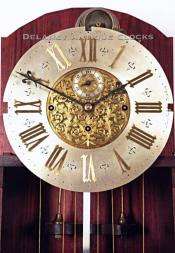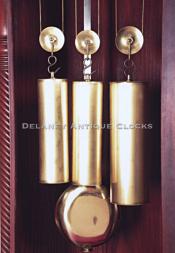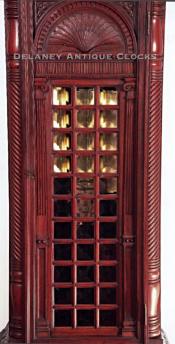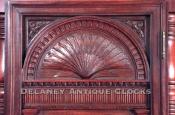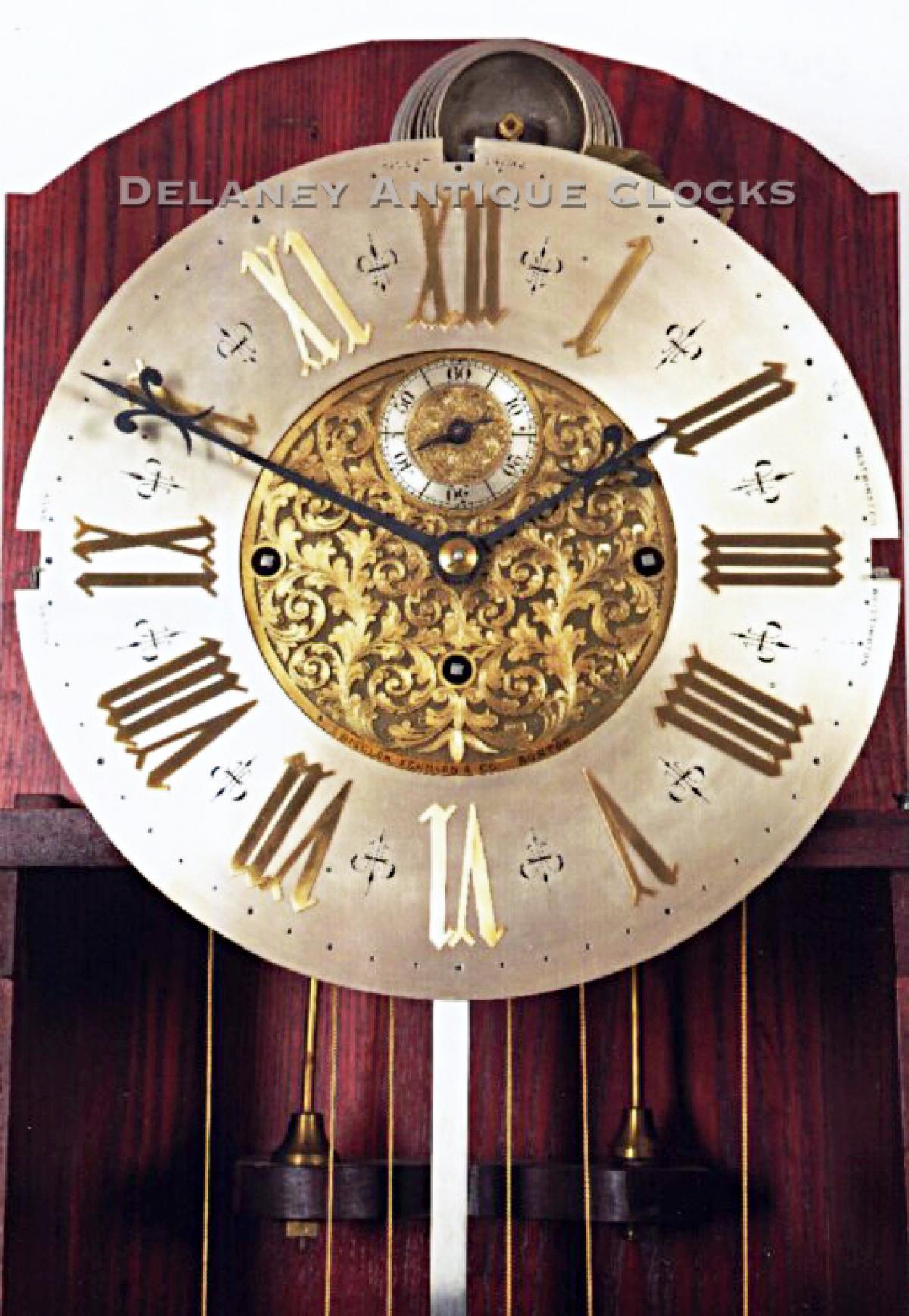Bigelow, Kennard & Co. of Boston, Massachusetts. A three train hall clock. UU-97.
John Bigelow was born in Westminster, Massachusetts, on May 26, 1802. His parents were Luke Bigelow and Asenath (Winship) Bigelow. John was trained as a silversmith and was first listed as doing business in Boston as early as 1824 as John Bigelow & Co. In the early 1830s, he was joined by his brothers Alanson & Abraham O. Bigelow, prompting the firm's name to change to Bigelow Bros. & Co. The company expanded its business from jewelry to include high-quality clocks, watches, and altar silverware. Their merchandise was privately manufactured and sold at their store in Boston. Martin Parry Kennard of Brookline, Massachusetts, joined the firm in 1845, which prompted the company to change its name to Bigelow Bros. & Kennard until 1863. From 1863 to 1972, the firm was called Bigelow, Kennard & Co. The store was closed in 1971-72.
This case is constructed in mahogany and retains an older finish that has been recently rubbed out. It has a super clean and crisp presentation. This case design incorporates numerous carved moldings and architectural patterns as well as a number of stepped panels in it's design. These decorations are artfully displayed throughout the case form.
This case is raised up off the ground on four large carved hairy paw feet. These are applied to the bottom of the case. The base section is fitted with an applied panel. It is framed with a series of moldings. The panel is decorated with a floral-themed carving. It is light and well-executed. The waist section of this clock case is stepped in or pinched. The center of this section features a large door that is fitted with thirty-three separate panels of beveled glass. Through this, one can view the motion of the pendulum while the clock is in operation. You can also see the three brass-covered weights that power the movement when they are at window level. These brass-faced components are highly finished. The glass panels are flanked by carved columns which are presented inside the frame of the door. Above is a very interesting detail a wonderfully carved shell. This shell is expertly made, and the details are crisp. This door is hinged on the right. The front corners of this waist section are fitted with turned columns. A number of turning patterns are exhibited in this architectural detail. The spiral pattern is distinctive. Both columns terminate in Doric-style capitals. Both the upper and lower waist moldings are decorated with rich carvings. The bonnet rests on top of the upper molding. The molded arch pediment is well-formed and accented with decoratively carved details. Three wonderfully cast brass pineapple finials are supported on plinths. These are outstanding and are original to this clock. The sides of the bonnet are fitted with access doors. The doors are fitted with cast grates that have been treated with a golden wash. The bonnet door is constructed with a cast brass bezel that is fitted with thick beveled glass. Through this, one views the brass dial.
The bonnet door opens to access the brass composite circular dial. Applied details such as the engraved chapter ring, polished brass raised numerals, and pierced center mat is often found on clocks of this high quality and finish. This is the highest quality. This dial is signed in the center section "Bigelow, Kennard & Co., Boston ." Three levers on the outside of the dial give the operator options. The silent / chime lever is located above hour twelve. The selector that allows one to choose the Westminster or Whittington tunes is located outside of hour number three. The last sector allows one to choose to hear the hours only being struck. This is located outside of hour number nine.
This brass-constructed movement was made to the highest standards of the day. The plates are extremely thick and heavy. They are supported by heavily constructed and turn posts. This movement is a three-train design. This means that it will keep time or run for eight days on full wind. It is designed to strike each hour on a large coil gong. Because of its long length, the tone is deep and low. It will also strike each quarter hour. One has a choice of tunes. Westminster is a four-gong sequence. This clock strikes the Westminster tune on four coil gongs. The second choice is Whittington. This tune requires eight notes. As a result, a nest of eight bells is mounted on a rack above the movement. The quarter-hour sequence is progressive. Again, the sound is wonderful.
This tall case or hall clock stands an impressive 100.5 inches tall or 8 feet 4.5 inches tall and measures 22.5 inches wide, and is a full 18 inches deep. This clock was made circa 1890.
Inventory number UU-97.
John Bigelow was born in Westminster, Massachusetts on May 26, 1802. His parents were Luke Bigelow and Asenath (Winship) Bigelow. John was trained as a silversmith and is first listed as doing business in Boston as early as 1824 as John Bigelow & Co. In the early 1830's, he was joined by his brothers Alanson & Abraham O. Bigelow prompting the firm's name to change to Bigelow Bros. & Co. The company expanded its business from jewelry to include high quality clocks, watches and altar silverware. Their merchandise was privately manufactured and sold at their store in Boston. Martin Parry Kennard of Brookline, Massachusetts joined the firm in 1845, which prompted the company to change its name to Bigelow Bros. & Kennard until 1863. From 1863 to 1972 the firm was called Bigelow, Kennard & Co. The store was closed in 1971-72.



